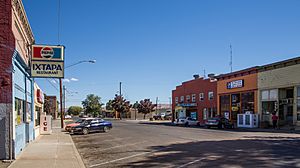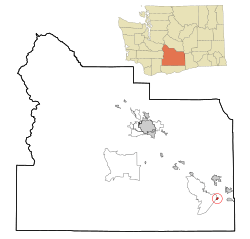Mabton, Washington facts for kids
Quick facts for kids
Mabton
|
|
|---|---|

Main Street
|
|

Location of Mabton, Washington
|
|
| Country | United States |
| State | Washington |
| County | Yakima |
| Incorporated | November 7, 1905 |
| Government | |
| • Type | Mayor–council |
| Area | |
| • Total | 0.82 sq mi (2.13 km2) |
| • Land | 0.82 sq mi (2.13 km2) |
| • Water | 0.00 sq mi (0.00 km2) |
| Elevation | 715 ft (218 m) |
| Population
(2020)
|
|
| • Total | 1,959 |
| • Estimate
(2021)
|
1,948 |
| • Density | 2,752.43/sq mi (1,062.70/km2) |
| Time zone | UTC-8 (PST) |
| • Summer (DST) | UTC-7 (PDT) |
| ZIP code |
98935
|
| Area code | 509 |
| FIPS code | 53-40980 |
| GNIS feature ID | 1512417 |
Mabton is a city located in Yakima County, Washington, United States. In 2020, about 1,959 people lived there. The city was officially started in the early 1900s. It is found on the eastern edge of the Yakama Indian Reservation.
Contents
Mabton's History: How the City Began
The land where Mabton is now was first home to the Yakama people. They were moved to a special area called a reservation in 1855. Mabton became a town because of the Northern Pacific Railway. The railway arrived around 1884 and built a water tower and a small house for workers.
Early Development and Naming Mabton
Nothing else was in Mabton until 1892. That year, Sam P. Flower built a store and a warehouse. He also became the town's first postmaster, which meant he was in charge of the mail.
The name "Mabton" came from Charlie Sandburg, a Swedish railway worker. He suggested "Mabletown" after the wife or daughter of a railway official. This official had been kind to the track workers during an inspection.
Growth and Official Incorporation
By 1895, Mabton was growing. It had several stores, a hotel, a train station, and a school. The Mabton Townsite Company, started by Sam P. Flower and J.A. Humphrey, officially mapped out the town in 1902. By 1904, Mabton had more than a dozen businesses and its own newspaper. The town of Mabton officially became a city on November 7, 1905.
Today, most people in Mabton work in farming. They especially focus on growing hops, which are used to make beer, and grapes.
Supporting Education in Mabton
The Mabton School District has received help from the Bill and Melinda Gates Foundation many times. This help has improved education for students:
- From 2000 to 2005, they received $558,000. This money helped students get better access to computers and other technology.
- In 2001, Mabton High School was chosen for the Washington State Achievers Program. The school got a share of over $9 million to make school better. Students also got over $100 million for college scholarships.
- From 2001 to 2006, over $40,000 helped improve high school education. It also made it easier for students to go to college.
- From 2001 to 2004, over $125,000 supported training programs for teachers. This was done with Heritage College.
A Noteworthy Event Near Mabton
On December 23, 2003, a small ranch near Mabton was where the first confirmed case of a specific animal health issue was found in the United States. It was later confirmed that the animal had come from Canada.
Mabton's Location and Surroundings
Mabton is located at the eastern end of the Yakama Indian Reservation. It is south of the Yakima River. Nearby cities include Sunnyside and Grandview. The city covers about 0.80 square miles (2.1 square kilometers) of land.
Mabton's Population Over Time
| Historical population | |||
|---|---|---|---|
| Census | Pop. | %± | |
| 1910 | 666 | — | |
| 1920 | 547 | −17.9% | |
| 1930 | 423 | −22.7% | |
| 1940 | 485 | 14.7% | |
| 1950 | 831 | 71.3% | |
| 1960 | 958 | 15.3% | |
| 1970 | 926 | −3.3% | |
| 1980 | 1,248 | 34.8% | |
| 1990 | 1,482 | 18.8% | |
| 2000 | 1,891 | 27.6% | |
| 2010 | 2,286 | 20.9% | |
| 2020 | 1,959 | −14.3% | |
| 2021 (est.) | 1,948 | −14.8% | |
| U.S. Decennial Census 2020 Census |
|||
What the 2010 Census Showed
In 2010, there were 2,286 people living in Mabton. There were 528 households, with most being families. The city had about 2,857 people per square mile.
Many different groups of people live in Mabton. About 91.9% of the population identified as Hispanic or Latino.
Most households (69.1%) had children under 18 living there. The average household had about 4.31 people. The average age in Mabton was 23.6 years old. About 39.4% of residents were under 18.
Learning and Libraries in Mabton
Mabton has a city library that is open several afternoons and evenings each week. It has over 5,000 hardcover books and more than 2,000 paperback books. The library also has 26 different magazines. Many of the books and magazines are available in Spanish.
Famous People from Mabton
- Rachel Ruelas: She is the current mayor of Mabton.
- Mel Stottlemyre: He was a famous baseball pitcher for the New York Yankees. He won 164 games for them from 1964 to 1974. He had three seasons where he won 20 games or more. His son, Mel Stottlemyre Jr., is also a pitching coach for the Miami Marlins.
See also
 In Spanish: Mabton (Washington) para niños
In Spanish: Mabton (Washington) para niños

